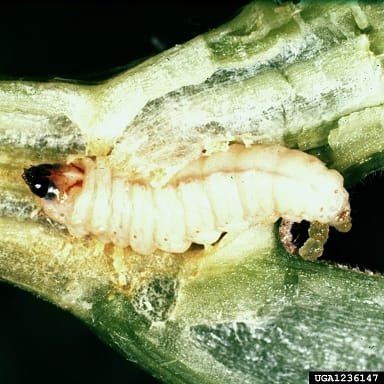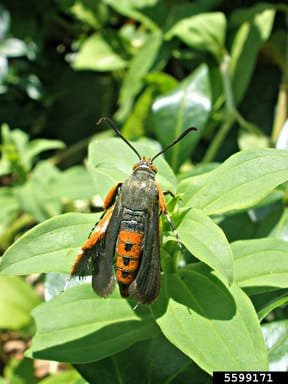What Are Squash Vine Borers?
Squash vine borers (Melittia satyriniformis) are a significant threat to squash plants, known for their destructive larvae that feed on the vascular tissues of the plant. These pests are identifiable by their distinctive adult form, which resembles a wasp. The adult moths have a wingspan of about 1 to 1.5 inches and are characterized by a brownish-tan color with black markings. They typically emerge during the summer months, around June to July, laying their eggs at the base of squash plants. Understanding the appearance and behavior of squash vine borers is crucial for managing their impact on crops.
The life cycle of the squash vine borer comprises several stages, starting with the egg stage. Female moths lay orange to yellow eggs near the stems of host plants, where the larvae later hatch. When the larvae emerge, they burrow into the stems, causing severe damage to the plant’s ability to transport nutrients and water. As they grow, larvae can create extensive tunnels that weaken the stems, leading to wilting and ultimately the death of the plant. Identifying signs of squash vine borers includes looking for frass (sawdust-like excrement), wilting leaves, and chewed stems, which indicate the presence of these pests.
Managing squash vine borers requires early detection and effective intervention. Recognizing the signs of squash vine borers can help gardeners implement squash vine borer prevention strategies, such as crop rotation or the use of row covers. It is imperative to monitor your squash plants regularly, especially during their vulnerable growth stages, to minimize damage and protect yields. By understanding their life cycle and behavior, gardeners can better prepare and respond to squash vine borer infestations, thereby safeguarding their squash crops.
How Do Squash Vine Borers Overwinter?
Squash vine borers, scientifically known as Melittia cucurbitae, exhibit a fascinating life cycle that enables them to survive the colder months. During winter, these pests enter a phase known as overwintering, which primarily occurs in the larval and pupal stages. After completing their feeding cycle during the warm summer months, adult borers lay eggs at the base of squash plants. Once the larvae hatch, they burrow into the stem of the plant, where they feed and grow until the onset of colder weather prompts their transition to a dormant state.
In this dormant phase, squash vine borers can remain in the pupal stage within the husks of decaying plant material or in the soil at the base of previous squash crops. This strategic choice of habitat protects them from the harsh winter conditions, as the insulating properties of the soil or organic material help maintain a more stable temperature. Additionally, the moisture provided by decomposing plant matter further ensures their survival during extended periods of frost.
The emergence of adult squash vine borers typically coincides with the warming temperatures of spring. As the soil begins to warm and their surrounding environment becomes hospitable again, these borers break free from their dormancy. The timing of their emergence is critical, as it marks the beginning of their lifecycle anew, setting them on a path to infest fresh crops and potentially cause significant damage to squash plants. Understanding the overwintering habits of squash vine borers is essential for effective management practices. Recognizing the signs of squash vine borers early can aid gardeners in implementing squash vine borer prevention strategies before these pests become an overwhelming threat to their crops.
How to Prevent Squash Vine Borers Using Bt
Bacillus thuringiensis, commonly referred to as Bt, is a natural bacterium widely recognized for its effectiveness in controlling certain caterpillar pest populations, including the larvae of squash vine borers. When attempting to manage squash vine borer infestations, understanding how Bt works and the best practices for its application is essential for effective treatment.
Bt functions by producing a toxin that specifically targets the digestive systems of certain insects, including squash vine borers. Upon ingestion, the larvae experience a disruption in normal physiological processes, leading to their eventual death. This makes Bt an environmentally friendly option for those seeking to eliminate the pesky larvae without harming beneficial insects. To use Bt against squash vine borers, it is crucial to start applying the treatment at the right time, before the vine borers arrive for the season. The squash vine borer larvae must ingest the Bt for the spray application method to work. Applying Bt is most effective when the larvae are newly hatched and actively feeding on the outside of the plant, generally in late spring through early summer.
Note: If larvae have already entered the plant, spraying the plant with Bt won’t kill the larvae already inside the plant. You’ll need to try methods in the following section.
To ensure efficient application of Bt, follow these best practices: apply the product by thoroughly spraying it on the plant, focusing on vulnerable areas, such as the base of the stem, where signs of squash vine borers often occur. Spraying early in the morning or in the late afternoon can maximize the effectiveness, as it minimizes degradation caused by direct sunlight. Additionally, repeating the application as directed by the manufacturer, especially after heavy rainfall, can further enhance the control of squash vine borers.
When using any biopesticide, safety is an important consideration. Since Bt is derived from natural sources, it is generally safe for humans and pets when used as directed. Nevertheless, it is advisable to wear gloves and a mask during application to avoid any potential irritation or allergic reaction. Thus, employing Bt as a treatment method for squash vine borers provides gardeners with a practical and sustainable solution, contributing to healthier, thriving squash plants. In summary, understanding how to effectively utilize and apply Bt is key to managing squash vine borer infestations successfully.
Here’s a link with more information on the Bt that we recommend and use on our farm.
How to Remove or Kill Squash Vine Borer Larvae Already Inside Plant Stems
Dealing with squash vine borers requires a systematic approach to effectively remove these pests and protect your squash plants. The first step in managing an infestation is to accurately identify the signs of squash vine borers on your plants. Look for wilting stems, frass (sawdust-like excrement), and holes at the base of the plant. Recognizing these symptoms early can prevent more extensive damage, allowing for timely intervention.
Once you have confirmed an infestation, physical removal is one of the best methods to combat squash vine borers. Carefully inspect the stems of your plants for any visible larvae or eggs. If you find them, use a sharp knife to cut half-way through the affected stem and remove the borers. After extraction, seal the damaged area by mounding soil over it to promote healing and new root development.
If you are uncomfortable slicing open the stem on your squash plant, you can also use a syringe with properly mixed Bt and insert the needle and apply the mixture several inches above and directly into the burrowed hole. We’ve had more long-term success spraying the squash plants regularly over this method, but the syringe method has worked at times. The same can be said with cutting the plant since there’s no guarantee the plant will make it through the incision, the existing infestation damage, and prosper again. It really depends on how much damage was done to the plant before cutting it open, which will likely determine whether the plant survives or not.
If the infestation is severe and none of the above methods worked, it may be necessary to remove the whole plant and burn it to prevent the squash vine borers from spreading to nearby plants or overwintering.
Preventing future infestations is as critical as removing existing pests. Squash vine borer prevention includes rotating crops, planting resistant varieties (Cucurbita moschata family), and using row covers to protect young plants. Regular monitoring and inspection can help you catch squash vine borer activity early, minimizing your squash plants’ exposure to these destructive pests. Additionally, integrating other pest management strategies, such as companion planting, can encourage healthier growth and reduce vulnerability. By adopting these measures, you can mitigate the impact of squash vine borers and foster a thriving garden.
Squash Vine Borer Larvae

Photo Credit: Clemson University – USDA Cooperative Extension Slide Series, Bugwood.org
Squash Vine Borer Moth

Photo Credit: Ansel Oommen, Bugwood.org
